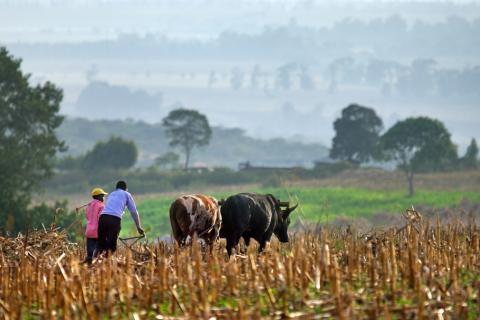Neil Sorensen joined the Land Portal as its Communications Specialist in October 2015. He has extensive experience leading communications for international organizations and developing relationships with civil society, donors, intergovernmental agencies, the media and the private sector. Previously, Neil worked for the International Fund for Agriculture Development (IFAD) as a Governing Bodies Officer and Strategic Adviser to the Secretary of IFAD. He has also led communications for three international organizations, including the International Land Coalition, the International Federation of Agricultural Producers (IFAP) and the International Federation of Organic Agriculture Movements (IFOAM). He holds a Master’s degree in Global Diplomacy from the University of London School of Oriental and African Studies (SOAS) as well as a Bachelor’s degree with a double major in German and Sociology from St. Cloud State University.
Details
Location
Contributions
Displaying 711 - 720 of 1145Greening Governance Seminar Series: Reducing Land Rights Inequity between Communities and Companies
This event focuses on the challenges Indigenous Peoples and communities face in acquiring legal rights to their land, the loopholes companies can often take, and ways countries can simplify complex procedures.
Indigenous Peoples and rural communities occupy more than half of the world’s land, but they legally own just 10 percent of land globally.
Land and Conflict
Land is often a critical aspect of conflict: it may be a root cause or trigger conflicts or may become an issue as the conflict progresses. Conflicts lead to forced evictions; the people who are displaced by conflict need somewhere to live and some land to farm or to graze their animals, often leading to further disputes over the use of land and other resources.
Unprecedented Wave of "Criminalization" Sweeping the Globe to Silence Indigenous Peoples
New UN report highlights drastic increase in violence and legal harassment driven by rapid expansion of development projects on indigenous lands
Annual Report on Human Rights Defenders at Risk in 2017
As human rights defenders around the world put their lives on the line to challenge dictators, destructive multi-national corporations, religious conservatives, and oppressive regimes, there pervades a well-resourced and coordinated strategy of defamation, criminalisation and violence deployed to intimidate, marginalise and silence peaceful, powerful activists. The human cost has been high. More than 300 human rights defenders were murdered in 2017. Yet, in spite of this violence, there are more HRDs, working on more issues, in more countries, than ever before.
Front Line Defenders
Front Line Defenders was founded in Dublin in 2001 with the specific aim of protecting human rights defenders at risk (HRDs), people who work, non-violently, for any or all of the rights enshrined in the Universal Declaration of Human Rights(UDHR). Front Line Defenders addresses the protection needs identified by HRDs themselves.
Attacks and criminalization of Indigenous Peoples defending their lands and rights
The Secretariat has the honour to present to the Human Rights Council the report of the Special Rapporteur on the rights of indigenous peoples, prepared pursuant to Council resolution 33/12. In the report the Special Rapporteur briefly refers to the activities undertaken since the submission of her last report, provides a thematic study on attacks against and the criminalization of indigenous human rights defenders and reflects on available prevention and protection measures. She concludes with recommendations on how various stakeholders can prevent violations and improve protection.
A Better World Volume 4
With the establishment of the UN Sustainable Development Goals (SDGs) in 2015, the Human Development Forum at Tudor Rose has expanded its publishing operation with the creation of a series of volumes entitled A Better World, each dedicated to one or more of the 17 SDGs. This volume, published in September 2018, covers Goal 15: Life on Land, and particularly Goal 15.3, which aims to achieve Land Degradation Neutrality
(LDN) globally by 2030.
A visit to displaced communities in north Honduras reminded me why we need Prindex
Malcolm Childress visited Honduras in April as part of a fact-finding and speaking delegation sponsored by the US State Department.
On the northern coast of Honduras, palm forests give way to white sands, blue seas and one of the world’s most spectacular coral reefs. But, in a story that will be familiar to observers of land rights worldwide, that beauty has brought developers eager to build, and conflict around the ownership of land occupied and claimed by longstanding Garifuna communities.
When it comes to land rights, perception is (almost) everything
In 2015 the UN agreed a new tranche of global sustainable development goals, signed up to by all member states and due to be achieved by 2030. Among them was a target to increase not only the proportion of adults with legally documented property rights, but also the proportion of adults who perceived their property rights to be secure, whether legally documented or not.











